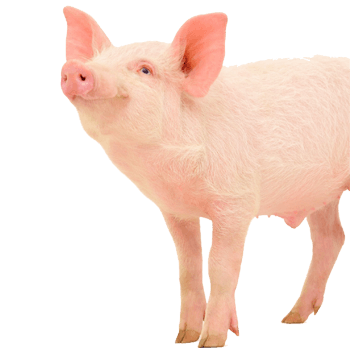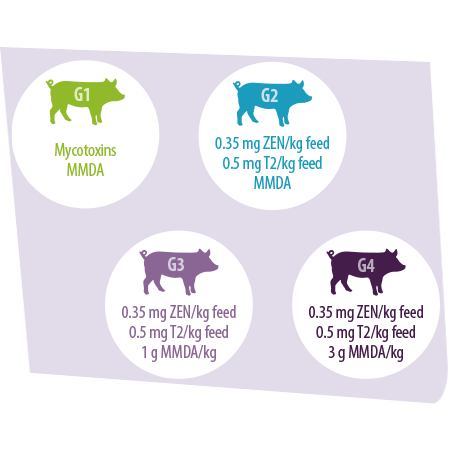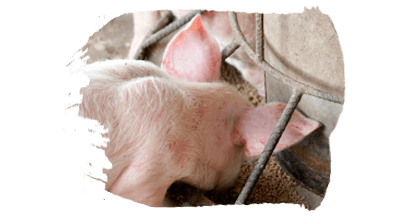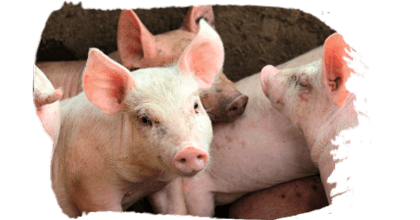Summary
OBJECTIVE
OBJECTIVE

MATERIALS & METODS
MATERIALS & METODS
The multicomponent mycotoxin detoxifying agent (MMDA; Patent Co, Misicevo, Serbia) evaluated consisted of:
- ⇰ Modified zeolite
- ⇰ Bacillus spp.
- ⇰ Yeast cell wall
- ⇰ Sylmarin
In total, 112 post-weaning barrows and gilts (Danbred x Pietrain) from the 25th day of age (day 0 of the trial) until the 66th day of age (end of trial) were allocated in four trial groups.
Each group consisted of 28 pigs placed in seven pens (replicates) with four animals in each pen.
![]() Group G1 served as a control group that received feed without any mycotoxins or MMDA.
Group G1 served as a control group that received feed without any mycotoxins or MMDA.
![]() Group G2 received feed with spiked corn and wheat reaching contamination levels of 0.35 mg ZEN/kg and 0.5 mg T2/kg feed.
Group G2 received feed with spiked corn and wheat reaching contamination levels of 0.35 mg ZEN/kg and 0.5 mg T2/kg feed.
![]() Group G3 received contaminated feed (similar contamination levels with G2 group) with the addition of 1 g MMDA/kg.
Group G3 received contaminated feed (similar contamination levels with G2 group) with the addition of 1 g MMDA/kg.
![]() Group G4 received contaminated feed (similar contamination levels with G2 group) with the addition of 3 g MMDA/kg.
Group G4 received contaminated feed (similar contamination levels with G2 group) with the addition of 3 g MMDA/kg.


 Growth performance (body weight, average daily gain, feed conversion ratio), as well as hematological and serum biochemical parameters, fecal scoring, gross pathology, and mycotoxins residue levels in liver, spleen, kidneys and muscle tissue were assessed.
Growth performance (body weight, average daily gain, feed conversion ratio), as well as hematological and serum biochemical parameters, fecal scoring, gross pathology, and mycotoxins residue levels in liver, spleen, kidneys and muscle tissue were assessed.
RESULTS
RESULTS
Results suggested that inclusion of MMDA in trial diets induced dose-dependent reduction of genital organ relative weight (ovaries, cornu uteri and vagina-vestibule) and vulva size, which had been increased due to ZEN ingestion in G2 group.
Additionally, in both groups that received MMDA, significantly reduced residue levels of ZEN in liver and kidney samples were observed, in comparison with G2 group.
A significant reduction of the residue levels of T-2/HT-2 toxins was also observed in kidney samples of MMDA-fed groups when compared with G2 group.


 Taken together, MMDA added to diets containing ZEN and T-2 toxin has a dose-dependent affinity for ZEN and, to a lower extent, for T2 toxin, whereas its beneficial effects seem to be greater at inclusion levels of 3 g MMDA/kg feed.
Taken together, MMDA added to diets containing ZEN and T-2 toxin has a dose-dependent affinity for ZEN and, to a lower extent, for T2 toxin, whereas its beneficial effects seem to be greater at inclusion levels of 3 g MMDA/kg feed.Autores
1Jog Raj, 1Marko Vasiljević, 2PanagiotisTassis, 1Hunor Farkaš and 3KlausMänner
1PATENT CO, DOO., Serbia
2School of Veterinary Medicine, Aristotle University of Thessaloniki, Greece
3Institute of Animal Nutrition, Freie Universität Berlin, Germany
Referencias
Livestock Science, 242, 104295. doi: 10.1016/j.livsci.2020.104295




 Micotoxicosis prevention
Micotoxicosis prevention